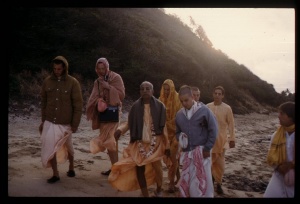SB 3.9.2

A.C. Bhaktivedanta Swami Prabhupada
TEXT 2
- rūpaṁ yad etad avabodha-rasodayena
- śaśvan-nivṛtta-tamasaḥ sad-anugrahāya
- ādau gṛhītam avatāra-śataika-bījaṁ
- yan-nābhi-padma-bhavanād aham āvirāsam
SYNONYMS
rūpam — form; yat — which; etat — that; avabodha-rasa — of Your internal potency; udayena — with the manifestation; śaśvat — forever; nivṛtta — freed from; tamasaḥ — material contamination; sat-anugrahāya — for the sake of the devotees; ādau — original in the creative energy of matter; gṛhītam — accepted; avatāra — of incarnations; śata-eka-bījam — the root cause of hundreds; yat — that which; nābhi-padma — the navel lotus flower; bhavanāt — from the home; aham — myself; āvirāsam — generated.
TRANSLATION
The form which I see is eternally freed from material contamination and has advented to show mercy to the devotees as a manifestation of internal potency. This incarnation is the origin of many other incarnations, and I am born from the lotus flower grown from Your navel home.
PURPORT
The three deities Brahmā, Viṣṇu and Maheśvara (Śiva), the executive heads of the three modes of material nature (passion, goodness and ignorance), are all generated from Garbhodakaśāyī Viṣṇu, who is described herein by Brahmā. From the Kṣīrodakaśāyī Viṣṇu, many Viṣṇu incarnations expand at different ages in the duration of the cosmic manifestation. They are expanded only for the transcendental happiness of the pure devotees. The incarnations of Viṣṇu, who appear at different ages and times, are never to be compared to the conditioned souls. The viṣṇu-tattvas are not to be compared to deities like Brahmā and Śiva, nor are they on the same level. Anyone who compares them is called a pāṣaṇḍī, or infidel. Tamasaḥ, mentioned herein, is the material nature, and the spiritual nature has a completely separate existence from tamaḥ. Therefore, spiritual nature is called avabodha-rasa, or avarodha-rasa. Avarodha means "that which completely nullifies." In the Transcendence there is no chance of material contact by any means. Brahmā is the first living being, and therefore he mentions his birth from the lotus flower generated from the abdomen of Garbhodakaśāyī Viṣṇu.